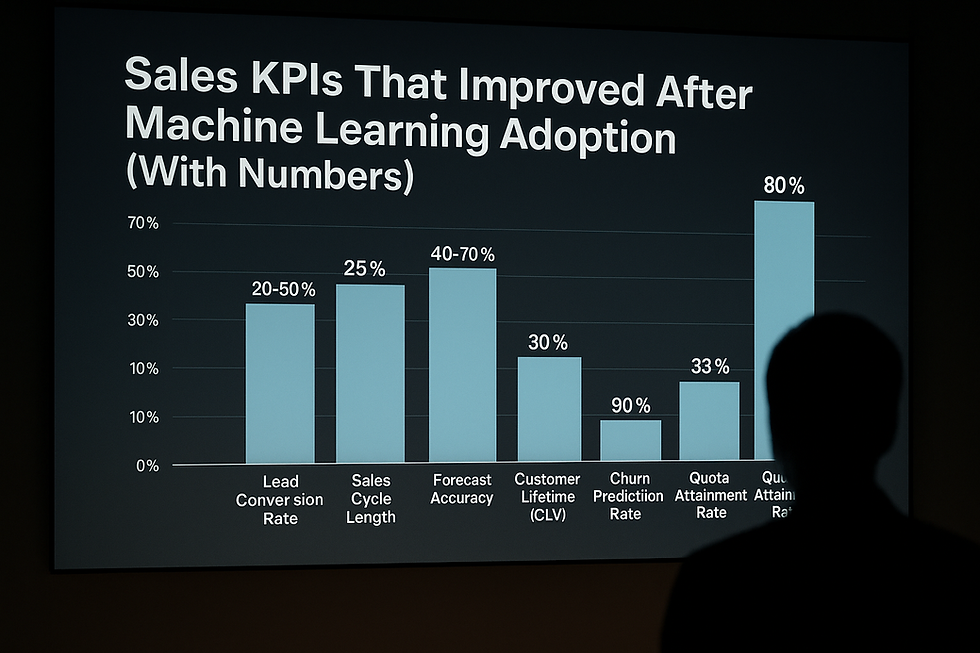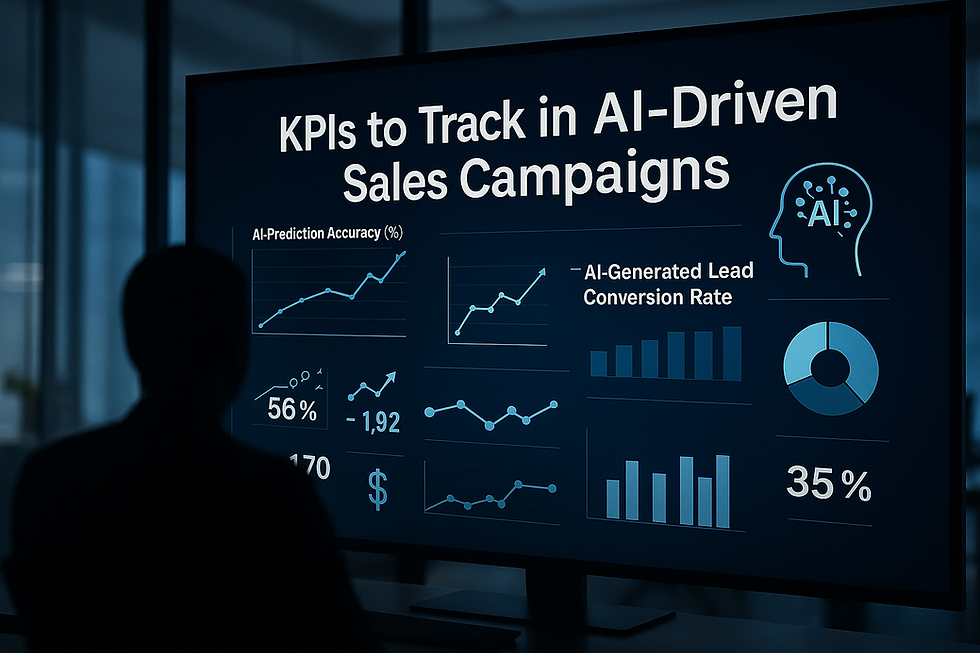Machine Learning Replacing Traditional Sales Reps? The Future of Selling Explained
- Muiz As-Siddeeqi

- Aug 24
- 4 min read

Machine Learning Replacing Traditional Sales Reps? The Future of Selling Explained
Sales isn't dying.
It's evolving—faster, deeper, and more intelligently than ever.
The cold calls, the brochures, the back-and-forths across endless email threads—they’re fading. In their place? Prediction engines, AI chatbots, and machine learning models that know what your customer wants before they do.
So it begs the question:
Will machine learning replace traditional sales reps?
Or is this just another overhyped tech prophecy?
Let’s dig into what’s really happening—through hard data, real companies, honest results, and the voices of those in the trenches.
Bonus: Machine Learning in Sales: The Ultimate Guide to Transforming Revenue with Real-Time Intelligence
Salespeople Aren’t Vanishing. But Their Role Is Morphing
Let’s kill the myth right now.
No, machine learning is not “firing” salespeople.
But it is changing the job description beyond recognition.
According to McKinsey’s 2024 report titled “The Future of B2B Sales: AI, Automation, and the Human Touch,” over 35% of repetitive sales tasks (like lead qualification, pricing, and quote configuration) are now being handled by ML algorithms 【source: McKinsey & Company, Future of B2B Sales, March 2024】.
That’s not replacement. That’s transformation.
The future belongs to reps who embrace these tools—not fear them.
The Rise of the “Cyborg Seller”: Half Human, Half Machine
Let’s talk about real-world numbers.
In 2023, Gartner’s Sales Innovation Pulse Report surveyed 500+ enterprise sales organizations. Here’s what they found:
72% of high-performing B2B sales teams already use ML-based lead scoring
66% of them employ AI-driven next-best-action engines inside CRMs
45% use machine learning to predict deal closures within ±10% accuracy
【source: Gartner, Sales Innovation Pulse 2023, published Q4 2023】
This isn’t about replacing reps.
It’s about augmenting them. Turning them into “cyborg sellers”—not just faster, but sharper, more accurate, and more customer-aligned.
What Sales Tasks Are Already Being Replaced (and Which Are Not)
Let’s get specific.
Here’s what machine learning is automating today, backed by real tools and stats:
Task | Status | Tool/Platform | Stat/Study |
Lead Qualification | Largely automated | MadKudu, Salesforce Einstein | 60% accuracy boost in MQL scoring (Salesforce 2024 study) |
Email Personalization | Heavily automated | Lavender AI, Copy.ai | 2x higher response rates when using AI-assisted emails (SalesLoft 2023 Benchmark) |
Deal Forecasting | Augmented by ML | Gong.io, Clari | 85% forecast accuracy with AI vs. 58% with human-only inputs (Gong Q1 2024 Data Report) |
Relationship Building | Human only | N/A | 0 ML tools capable of understanding emotions & nuances in B2B negotiations |
What’s not replaceable?
Building trust.
Negotiating with empathy.
Reading body language.
Relationship selling.
These are still 100% human territory. And likely will remain so for the foreseeable future.
Real Companies Using Machine Learning to Reshape Sales (Not Remove Humans)
1. HubSpot
In 2023, HubSpot integrated ML into its CRM for predictive lead scoring. Their internal study found that sales reps closed 23% more deals when guided by ML-scored leads 【source: HubSpot Annual Product Report 2023】.
Yet, they hired more sales reps, not fewer. Why? Because AI made them more effective, not obsolete.
2. Salesforce
Salesforce’s “Einstein AI” assists with opportunity scoring, forecasting, and email intelligence.
In a case study involving the tech firm Evariant, Einstein helped reduce their sales cycle by 27%. But not one human was let go. Instead, reps reported feeling “less overwhelmed and more strategic” 【source: Salesforce Success Story, Evariant, published June 2023】.
3. Zendesk
By using ML to auto-triage support requests (many of which are actually sales leads), Zendesk customers report a 22% faster hand-off to sales teams, resulting in quicker follow-ups and increased conversions 【source: Zendesk CX Trends Report 2024】.
Why Machine Learning Still Needs Human Reps
We’ve all received one of those emails.
The one that’s 90% right—but off just enough to feel robotic.
That’s where humans still win.
ML can predict, personalize, and prioritize. But it cannot:
Detect sarcasm or nuance in voice
Negotiate pricing under pressure
Rebuild trust after a mistake
Nurture long-term enterprise relationships
The Salesforce State of Sales Report 2024 emphasized this point, stating that 82% of customers still prefer speaking to a human for complex B2B purchases 【source: Salesforce, State of Sales 2024】.
Machine learning is the power tool, not the craftsman.
But Let’s Not Ignore This: Jobs Are Shifting
It would be dishonest to pretend everything’s rosy.
While ML isn’t replacing reps, it is replacing certain roles.
According to Forrester’s 2024 research, by 2026:
Entry-level SDR positions will drop by 17%
Inside sales roles with repetitive task loads will decline by 22%【source: Forrester Future of Work in Sales 2024, published April 2024】
But this doesn’t mean extinction.
It means evolution.
The reps who’ll survive and thrive?
The ones who learn:
How to read ML-driven insights
How to use AI to save time and deepen personalization
How to move beyond scripts into strategy
From Fear to Future: The 3 New Sales Roles Emerging
Sales Data Interpreters
These reps bridge the gap between ML outputs and human decisions. They translate AI recommendations into real-world action.
Sales-AI Architects
Not engineers—but reps who help shape ML logic. They test which data signals matter, fine-tune scoring models, and partner with ops.
Human-Led Conversationalists
These are the ones closing six-figure deals via Zoom. They lean into empathy, narrative, and relationship-building—while ML handles the grunt work behind the scenes.
What You Can Do Now (If You’re a Sales Leader)
This shift isn’t coming. It’s here.
Here’s what we recommend—based on real playbooks from companies like SAP, Snowflake, and HubSpot:
Upskill your reps in data literacy. Let them understand what ML is doing under the hood.
Audit your CRM and lead pipeline for automation opportunities (predictive scoring, email triggers, win/loss analysis).
Restructure your team around hybrid roles—don’t just hire reps. Hire revenue analysts, sales technologists, and ML-fluent coaches.
Integrate ML-based platforms like Clari, Drift AI, Gong, or People.ai into daily workflows. Don’t make AI “another tool.” Make it the tool.
Final Thoughts: ML Won’t Kill Sales Reps. But It Will Kill the Lazy Ones
Let’s be real:
Machine learning isn’t here to destroy the profession.
It’s here to demand excellence from it.
The reps who rely on personality alone, ignore data, avoid follow-ups, and resist change? Yes, they’re on borrowed time.
But those who adapt?
They’re not being replaced. They’re being amplified.
As Accenture’s 2024 Future of Sales Report concluded:
“The future of sales isn’t AI or humans. It’s humans who use AI better than anyone else.” 【source: Accenture Future of Sales Report, Nov 2024】
Let’s stop asking “Will ML replace reps”? Let’s start asking “What kind of reps will survive ML?”

$50
Product Title
Product Details goes here with the simple product description and more information can be seen by clicking the see more button. Product Details goes here with the simple product description and more information can be seen by clicking the see more button

$50
Product Title
Product Details goes here with the simple product description and more information can be seen by clicking the see more button. Product Details goes here with the simple product description and more information can be seen by clicking the see more button.

$50
Product Title
Product Details goes here with the simple product description and more information can be seen by clicking the see more button. Product Details goes here with the simple product description and more information can be seen by clicking the see more button.






Comments